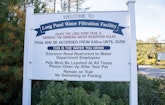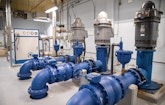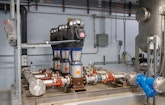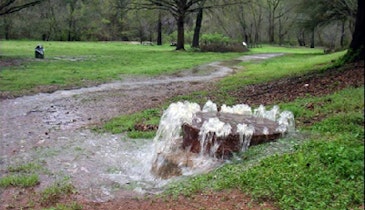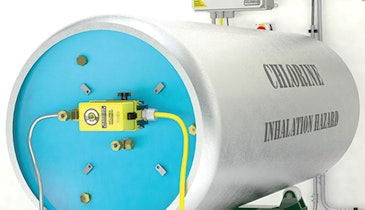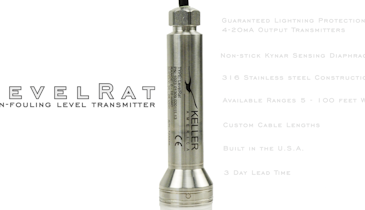
Michael Reghitto, chief operator of the Long Pond Water Treatment Facility, and Mark Moitoza, assistant chief operator, in the ozone generator room (WEDECO).
Interested in Treatment?
Get Treatment articles, news and videos right in your inbox! Sign up now.
Treatment + Get AlertsFor most of each day, the Long Pond Water Filtration Facility hums along with no operators present and only one team member on call.
The 8.4 mgd (design) surface water treatment plant in Falmouth, Massachusetts, relies on extensive automation and a team of five operators who, when on site for one daily shift, keep everything meticulously maintained and use lab testing as the basis for process fine-tuning.
The plant is the lynchpin of a water system that serves a coastal town on Cape Cod with 33,000 year-round residents and a population that balloons to more than 100,000 during the summer tourist season. The Long Pond plant uses a dissolved air flotation process with ozone treatment, deep-bed filtration and disinfection.
The $45.6 million plant, commissioned in 2017, has received a 2017 Excellence in Construction award from the Associated Building Contractors of Massachusetts, a 2017 Engineering News Record Regional Best Project Award, and a 2018 Silver Award for design and construction from the American Council of Engineering Companies.
The water system also includes a 3 mgd (design) greensand plant and four groundwater wells. All told, the system delivers up to 12 mgd to meet summer peak demands and 2.5 to 3 mgd in winter, says Michael Reghitto, chief water treatment operator.
UNIQUE SOURCE
Falmouth Township is home to wealthy homeowners as well as working-class residents. It is the site of the Falmouth Road Race, a qualifier for the Boston Marathon.
The primary source water, 150-acre Long Pond reservoir, has provided water since the 1890s, originally to supply steamships at Woods Hole, a neighborhood on the town’s south side. Long Pond is essentially a ground-level representation of the Cape Cod aquifer. It is spring-fed; the land around it is undeveloped and mostly owned by the town.
While pond water quality is generally good (typical turbidity 0.2 to 1.0 NTU), it is subject to seasonal issues. Pond turnover in the spring and fall can increase turbidity and organics, leading to color, taste and odor issues. Bacteria and algae counts rise in warm weather.
Until 2017, the water supply from the pond was unfiltered, dosed with chlorine gas for disinfection and sodium hydroxide for corrosion control. In 2008 the U.S. EPA issued its Long Term 2 Enhanced Surface Water Treatment Rule. That was the impetus behind designing and building the DAF treatment plant.
The greensand plant, opened in 2005, was paid for by the U.S. Air Force because of contamination from neighboring Joint Base Cape Cod. That plant is fed by two of the town’s four wells. An air stripping tower for VOC removal is followed by three GreensandPlus filters (Roberts Filter Group).
After two carbon contactors (also Roberts) and addition of sodium hypochlorite and sodium hydroxide, the water enters the distribution system. The remaining two wells pump directly to the distribution system after disinfection and pH adjustment.
Water from one of those wells is first treated in an ion exchange system (Evoqua Water Technologies) deployed in summers for removal of perchlorate and PFAS. This was also supplied by the Air Force to address PFAS contamination from the base.
Enhancing supply reliability for Falmouth and three other towns is an interconnect with a set of wells on the military base. “We and the towns around us draw water from it,” Reghitto says. “If for example we should have an emergency, the others would stop drawing from the interconnect and we would take all the water, up to 2,000 gpm. We have a good relationship with our neighbors, and it works out really well.”
EFFICIENT TREATMENT
The Long Pond plant is fed from two 24-inch gravity intakes that deliver to a raw-water building on the shore of the reservoir. From there three pumps (Goulds Water Technology, a Xylem Brand) send the water to the plant about 1,000 yards away. In a pre-oxidation basin, potassium permanganate can be added if necessary to address seasonal influxes of soluble iron and manganese.
The water is then dosed with polyaluminum chloride and sent to rapid-mix and flocculation chambers, and then to three Leopold DAF units (Xylem), where most of the impurities are removed. DAF is effective for treating low-turbidity, highly colored waters.
Conventional sedimentation requires large particles, typically hundreds of microns in diameter, to efficiently settle. DAF, on the other hand, uses air bubbles and floc particles only tens of microns in diameter to achieve flotation and solids removal. DAF can also use a lower volume of chemicals than gravity settling.
“I’ve worked on both,” Reghitto says. “In my experience DAF is much easier to operate and maintain, and it removes algae and other materials that do not settle well. In a sedimentation process, if your chemistry isn’t perfect, you can get carryover pretty easily. With the amount of air we add, it doesn’t matter if particles get a little too heavy. They’re always going to float. Turbidity fluctuations are a lot less than we’ve found with sedimentation.”
PRODUCTIVE CYCLE
The Long Pond plant is the first Grade 4 DAF facility in the state that is staffed for only one shift and operates fully remote overnight. The DAF units function as closed-loop systems. Water exiting the units is delivered to a lower level where pumps send 10% of it to air saturators that add air at 90 psi. That water returns to the start of the DAFs.
“We have baffled walls,” says Reghitto. “The flocculated water comes in, and nozzles inject the super-air-saturated water. It rides up the baffle walls and gives the air a chance to bind to the floc, which then floats. The clean water goes to the underdrains, which are 12-inch perforated PVC pipes.
“Instead of a chain-and-flight system to remove the floated material, we use a paddle wheel that’s fixed at the end. Spray nozzles along the walls turn on and push the blanket off the walls; then the paddle wheel turns and pulls the blanket off.”
Each DAF can treat 3,000 gpm; no more than two of the three units run, so that a spare is always available. DAF effluent is directed to an ozone building with two WEDECO EVO ozone generators and two ozone contactors for removal of taste and odor.
Ozonated water returns to the main treatment plant and passes through four Leopold deep-bed filters (Xylem) with four feet of granular activated carbon, one foot of sand, and one foot of gravel. The water then goes to a clear well where sodium hypochlorite and sodium hydroxide are added before distribution. Finished water turbidity averages about 0.05 NTU.
EYE ON RELIABILITY
A key feature of the plant is redundancy. The DAFs and other critical equipment operate with spares in place and are programmed to auto-rotate, distributing wear and tear evenly. “Every time the plant shuts down, everything in it auto-rotates,” says Reghitto. “We retain the ability, if we need to do maintenance, to set the order we want.”
Another reliability initiative is identifying and engineering out what Reghitto calls “single points of failure.” In one case, a combined filter effluent flowmeter that paces chemical dosing failed, “so then we weren’t able to pace our chemicals,” he says.
“In response we had our SCADA engineers (R.E. Erickson Company) install a toggle switch, enabling us to use readings from the four individual filter effluent meters. Now, if the combined filter effluent flowmeter fails, we can toggle that switch and use the total readings from the individual flowmeters to pace the chemicals.”
MAKING IT AUTOMATIC
The plant’s high level of automation makes it unique, says Reghitto: “We are the only Grade 4 facility in Massachusetts not manned 24/7/365.” R.E. Erickson and the Tata and Howard engineering firm were the system integrators. PLCs were supplied by Allen-Bradley (Rockwell Automation).
“We were able to prove at startup that we could run fully automated overnight,” says Reghitto. “All our water sources including the surface water are turned on and off automatically by tank level. All the sources have fixed flow rates that we set, with the exception of the surface water supply. That plant ramps up and down between 1,800 gpm and 5,850 gpm, depending on demand out in the system.
“Even when we’re here during the work day, we’re not necessarily adjusting when things come on and off. We do change setpoints to make sure we have adequate pressure and storage.”
Chemical feeds are also fully automated. “We rely heavily on our analyzers because everything is alarmed to shut down if something goes wrong,” Reghitto says. “It’s critical that our analyzers work right and are as accurate as they can be. So we do a lot of analyzer maintenance and calibration.
“We do maintenance on all our equipment, and we also do our daily general rounds and reporting. Then there is a lot of in-plant testing. We jar test once a week. We have a jar tester (Platypus) that mimics the DAF in the lab.”
While not state certified, the lab provides data essential to process control. Hach supplied, certified and calibrates all the lab instruments. The lab recently converted to reagentless Hach CL10sc ampiometric chlorine analyzers.
“All our analyzers are in the lab,” Reghitto says. “We have pumps all over the plant that deliver samples to the lab. Waste from the analyzers can be recycled to the head of the plant because there is no reagent in it.”
RIGOROUS MAINTENANCE
On the maintenance side, the Long Pond team has begun entering assets into the VieWorks software used town wide: “We’re importing all our facilities and equipment and will be able to auto-generate work orders.”
The team performs planned maintenance according to manufacturer recommendations, supplemented by predictive tools like thermal imaging, bearing temperature sensing on motors and vibration analysis.
While seasonal variability in demand for water presents challenges, the off-peak times provide opportunities for maintenance and repairs. “In winter everyone thinks we’re slow at the plant,” Reghitto says. “It’s actually our busiest time of year because we’re able to shut down and do maintenance. In summer it’s just full speed ahead with all our sources, and we make sure they stay running to meet the demand.”
Reghitto and his team enjoy operating the Long Pond plant and working in the special environment of Cape Cod. Last May an osprey tried building a nest atop the plant’s liquid oxygen vaporizer.
“We brought in Kevin Friel, an expert from The Osprey Project,” says Reghitto. “With their generous donation of a telephone pole and plans they provided, we were able to build a nest platform. Within a couple hours of installing the pole, the birds left our vaporizer and moved to their new home. One day we’re doing that, the next day we’re fixing a chemical feed leak, the next day we’re sampling. It’s a unique job. It’s pretty cool.”

